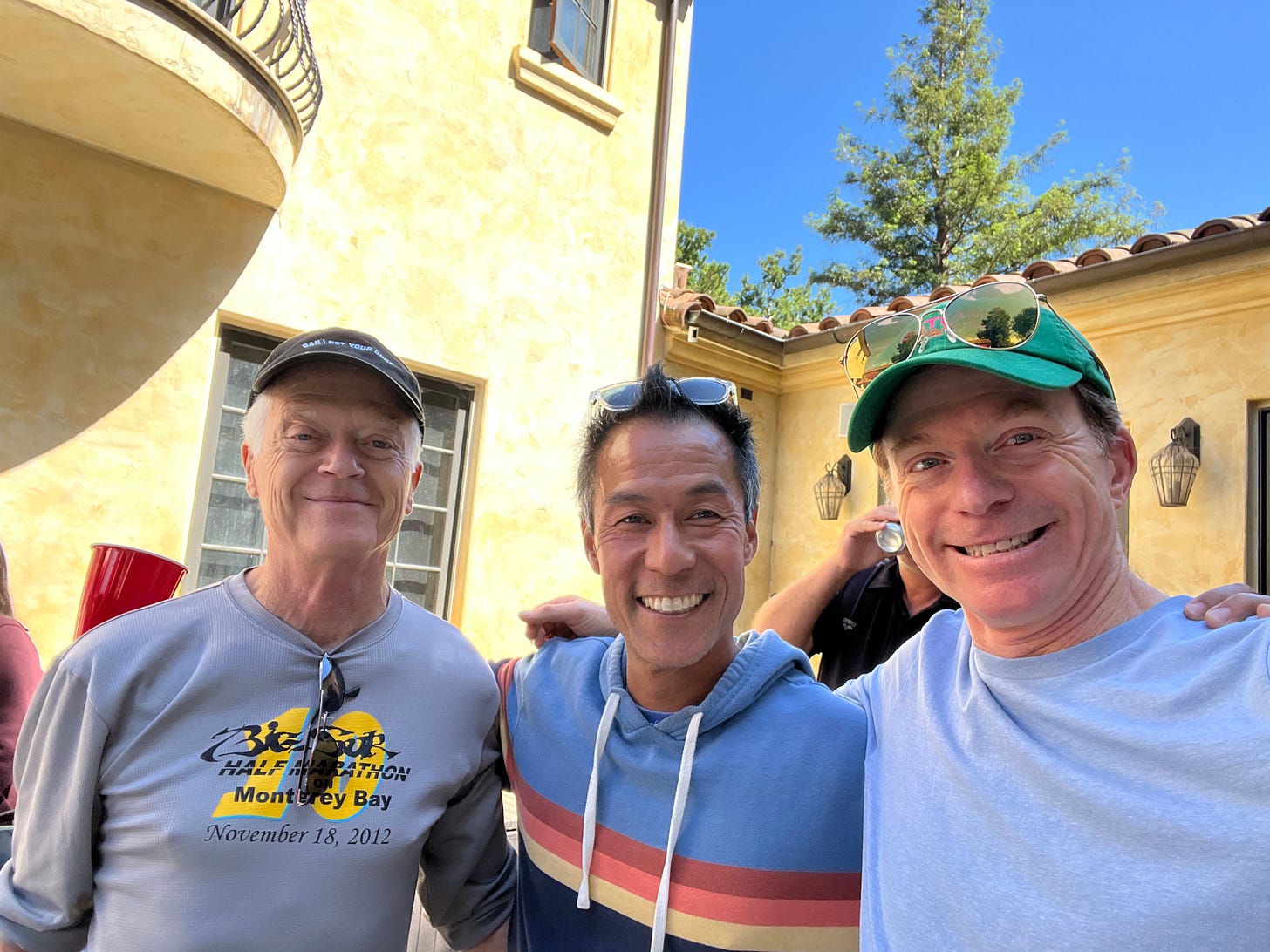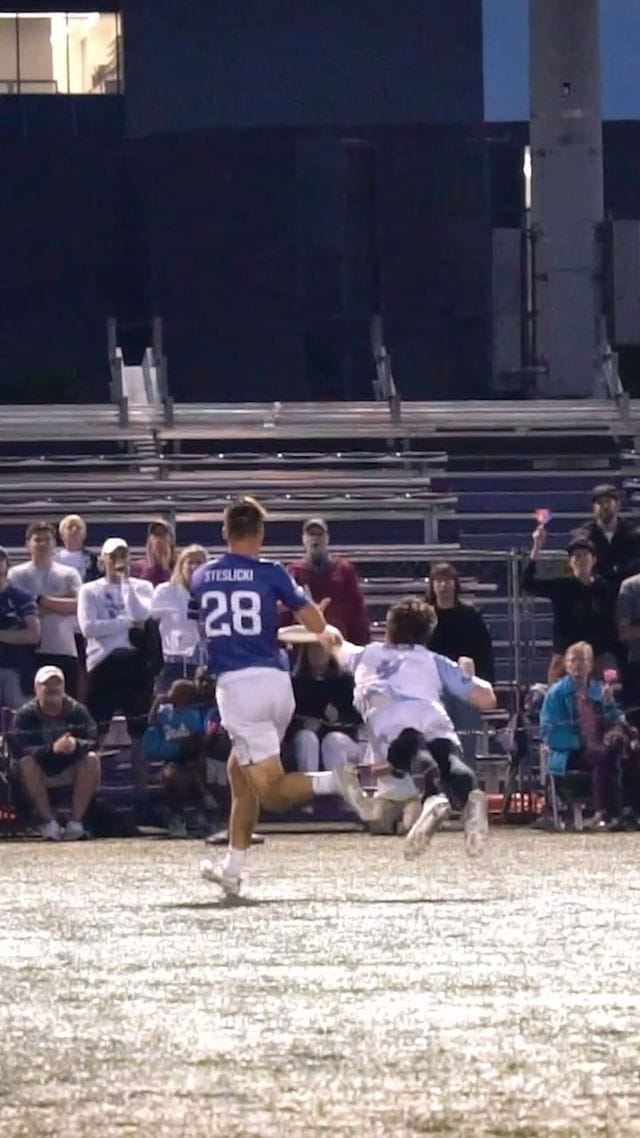#17 - Ultimate & Founders
How playing ultimate arms people with skills and tools to become founders of companies.
My fellow Stanford ultimate (frisbee1) teammate, med device company founder, Team Kim co-founder and BSIM Parktopus team member, Tom Goff and I shared an observation years ago. We noticed that an outsized number of ultimate players went on to become founders of companies, organizations and nonprofits. We recognized that we were in the Bay Area (Silicon Valley) and many of us had gone to Stanford, so company founding was already built into the region. But it still felt like there were aspects of playing ultimate that lent itself towards starting a company.
Ultimate
First a little about ultimate. When most people are asked to describe ultimate, the first image that comes to mind is a frisbee and a dog. Not ultimate.

Ultimate was birthed in 1968 in the waning days of Vietnam, the flourishing of flower power and a precursor to Woodstock. Salad days. Ultimate historians have it that Joel Silver, a New Jersey high schooler first learned to toss a disc around with Jared Kass, a camp teacher, and some other students during the summer. It was purported that some magic assistance was involved:
But since those early days, it has now blossomed into a sport that is played in many high schools, widely across colleges, throughout a competitive club system, professional leagues and for a while, was eligible for incorporation into the Olympics. It is a high intensity game requiring athleticism, strategy and communication to achieve success.
I first encountered ultimate at Stanford, my frosh year. Our RA Jim Bowman was a tremendous advocate for the game, having sporadically played on Stanford Men’s Ultimate Team (SMUT) and in competitive intramurals (IMs). That first year, our dorm, Arroyo, fielded a team that wound up making the finals of the ultimate IMs before losing to the Graduate School of Business’s team, which featured a former German national player, Volker.
Jim enchanted several of us impressionable frosh, by throwing the forehand. Prior to his introduction to this throw, I (sort of) knew how to throw a backhand (imagine swinging a tennis racket backhanded). It is a natural motion to toss a disc, grip around the edges and flicking your wrist away from your body to create a spinning motion. A series of backhands are thrown in this clip (along with a gorgeous layout block) below:
The forehand was different though. It was unintuitive, even though I had played quite a bit of tennis. The grip (held between your thumb and both index and middle fingers) and the wrist motion were foreign as was the follow through of the disc rolling off of your middle finger. Foley, Snitch, Dave and I (occasionally with Peiffer and Austin) spent many hours learning to master this throw in the Wilbur courtyard. An example of a forehand throw (along side a gorgeous lay out catch) is here below:
In ultimate, both throws are required to achieve a base level of competence at the game. Once the two are mastered, variants of throws are incorporated: push passes, high releases, inside outs, outside ins, pizza throws, biscuits, upside down throws like hammers, scoobers and thumbers. With the incredible diversity of ways to aerodynamically control the disc, ultimate becomes an incredibly fun game.
The Game
The game itself is played as an amalgamation of soccer, American football and basketball, on a field with roughly the dimensions of a football field2. In a typical ultimate game, seven offensive players seek to advance the disc by passing to one another (like soccer). The main constraint is that the player holding the disc is restricted in movement to one pivot foot (like basketball) and has a limited amount of time3 to pass the disc to another player (called a stall count, like a shot clock in basketball). The other offensive players run routes to create distance from a defender and become open (like football, or soccer) so that the person with the disc can complete a throw to that receiver. If the disc is intercepted, hits the ground, goes out of bound or is caught by a receiver out of bounds, or a stall count reaches ten, the play results in a turnover. Immediately the play starts up again with what originally was the defensive team switching to the offensive team and vice versa. The play continues, with teams alternating with each turnover, until one team scores by successfully catching a pass in the endzone. Games are played to a pre-agreed score.

The Spirit of the Game (SOTG)
Ultimate is a non contact sport. Picks, fouls and both unintentional and purposeful body contact that impedes a player from the position they have a right to, results in stoppage of play. But unlike most games, where fouls and such are the decision of referees and umpires, the players themselves make the calls.
This behavior is governed by the first, and most important, rule of ultimate, which is called Spirit of the Game, which states:
Rule 2.A.4: Spirit of the Game is a set of principles which places the responsibility for fair play on the player. Highly competitive play is encouraged, but never at the expense of mutual respect among competitors, adherence to the agreed upon rules, or the basic joy of play.
Note the word choices in the text of the rule which highlight the values of the sport: responsibility, encourage competition, mutual respect and joy of play.
Nearly all players, once indoctrinated into the sport, use SOTG as guidance for decision making. Sometimes this occurs outside the game itself, for example, when integrating new players to join a game. This happens in introductory local league play, pick up, all the way to elite levels of university, club and in some cases professional leagues. Players discuss a particular infraction and come to a mutually agreed upon resolution. Great plays (particularly the dramatic lay out catches or the “greatests”5) are cheered by all. This results in a player community that emphasizes fun, communication, conflict resolution and ultimately (no pun intended) inclusiveness.
Move to a different part of the country and stumble onto an ultimate game and you will be quickly invited to play, regardless of your skill. Pros will play with children, grandmasters will play with high schoolers, because there is room for many different textures to an ultimate game, all in the pursuit of fun. The game is inclusive; there are open divisions (anyone can play), women’s divisions and mixed divisions. It accommodates many different ages, youth up to great grand masters.
Ultimate and risky early stage startups
Dedication to this aspect of ultimate, the SOTG, is what Tom and I felt was a crucial factor for how players become founders. Company founders often need to be6:
responsible: accountability to teammates,
encourage competition: while doing so with a balance of cooperation with the broader picture in mind, like SOTG
mutual respect: building culture and navigating conflict
and joy of play: play, inclusion, fun, shared vision
Through ultimate, players develop skill sets for founding and leading new (and probably old) organizations and missions as highlighted by the diamond.
Tom and I had one more additional thought about how ultimate players grow into company founders. While the game is growing, with an estimated 8 million people playing around the world currently, it is still a bit of an off-beat sport. With its slight boho vibe7 it requires players to choose to play a sport that isn’t televised, doesn’t pay well at the professional levels and requires a certain quirkiness to be interested to begin with. According to Noam Wasserman, founders will on average make less than their fully employed lifetime income8; why do founders make these choices?
Maybe because it’s the offbeat path, it’s the focus on community over profits, cooperation alongside competition, respect for the team and the mission and ultimately the joy of play, of creating something that might impact someone else. Sounds a little bit like ultimate right? Or maybe a bit like art?
Friends and Evidence
Some notable ultimate founders that we played with and alongside, during our time on DOC, SMUT and CTR:
Premal Shah, co-founder of Kiva
Jit Bhattacharya, co-founder of BasiGo
Adrian James, co-founder of Omada Health
Nicole Beck, co-founder of Second Nature and ultimate hall of famer
Mandy Knox, co-founder of Redstart Designs
Shannon Miller, co-founder of Mainspring Energy
Rob Nail, co-founder of Velocity 11
John MacMahon, co-founder of Keberos, Mitre and Cytokind
Otis Chandler, co-founder of Goodreads
Mike Chang, co-founder of Cloudpic Global
Ben Olding, co-founder, well we’re never really too sure what Olding is up to but he’s done a lot
and many more (chime in if I’ve forgotten you, it’s not intentional!)
Other notables in and around ultimate: Jan Koum of Whatsapp, Steve Jurvetson and others stories

Frisbee often gets dropped because it is a trademark of the Whamo-O company. Players will refer to the flying object as a ‘disc’ and one of the major manufacturers is Discraft
Dimensions of the field have been modified over time.
Stall counts run to ten, which occurs over the span of seven seconds or so. A defender is required to be in t
Another “Rule 2A” has never been better written.
Greatests are plays that when the disc is caught by a receiver, leaping from inbounds but would result in the player landing out of bounds,
We recognize that not all company founders feel these attributes, but in our opinion, serve the early company quite well.
Playing in a tournament like Hats Hops and Hucks, Kaimana, Wildwood and you’ll see.
When ignoring the outliers of the mega wealth held by a few founders






